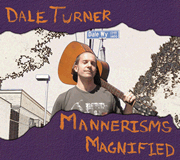
|
 |
|
|
|
|
|
|
With this installment of Psycho Licks, I'm presenting the final phase of a monster lesson called “Walking Basslines Bonanza”! In case you missed the first three, all four of these installments are geared towards developing walking basslines and using them in conjunction with chords—an often puzzling aspect of jazz guitar accompaniment (or solo jazz guitar)—to outline a G blues. In this particular lesson—an example of employing all the concepts presented to date in the context of a 12-bar jazz-blues—I'm using an approach similar to the type of accompaniment I attempted to unload in a recent “live” solo recording (guitar & vocal). This tune, “Twisted,” is posted elsewhere on this site. I believe the third time through the progression on that song is the closest to the example presented below. Hope you get a kick outta it! ***************************************** In Part 3 of this lesson (LICK #24) we took a look at creating a “chord pop” safety net by harmonizing the Mixolydian scale in 4ths. Using these voicings was one way we could approach delivering “walking basslines” in a static chord context—where the same chord is stated for numerous bars (i.e., unchanging harmony). Basically, we learned a way to deal with the scenario of when needed to grab a chord off of a non-chord scale tone (a note beyond that scale's tonic, 3rd, 5th, and b7th). ***************************************** USING WALKING
BASSLINES WITH 7TH CHORD INVERSIONS, The figure below opens with a common “G7” move that combines chromatic bass movement with chordal sound. This figure is then transposed verbatim (on the same string set) to outline “C7.” In measures 3-4, similar “G7”-based chord voicings and bassline approaches to what we've discussed in previous installments are used to descend to “C7” in measure 5. At this point, similar basslines are used to generate an ascending line, setting up the return of G7 in measure 7. This bar illustrates another common chromatic move (à la measures 1-2), albeit using 10ths intervals throughout. Meanwhile, in measures 9-10, a personal favorite “ii7-V7” move (between Am7-D7) of mine is employed, creating an ascending line along the 6th string. Finally, the turnaround portion of this jazz-blues (measures 11-12) features a fairly simple chord move to outline the closing “I7-VI7-II7-V7” sequence (i.e., G7-E7-A7-D7). Dig it!!!! Also note that, though all of the bassline figures presented to date involved fingerstyle technique, I played this one using only a pick throughout. This will put some pretty serious “muting” demands on your fret-hand. Of course, this passage is just as do-able using fingerstyle, just like the previous examples. Personally, so that you have maximum flexibility with these types of figures, I recommend being able to play this type of stuff both ways. Among other benefits, the ability to play these types of figures with a pick will allow you to impart a uniquely-percussive attack to these passages. Similarly, if you play them on acoustic steel-string (the version of “Twisted” I did was all played pickstyle), you'll be able to project more volume, and not shred your plucking hand's fingernails! Enjoy! (*You can hear the lick FAST by clicking HERE*) (*You can hear the lick SLOW by clicking HERE*)
To
help support this site's free online guitar lessons, please check out
my brand-new “full band” album of original compositions,
MANNERISMS
MAGNIFIED (now available through
CDBABY.com,
iTunes
and AMAZON.COM),
featuring me performing all the instruments (voices, guitar, bass, real
acoustic drums, piano, accordion, and mandolin). I also produced, arranged,
engineered, and did all the artwork/illustrations—intimate audio
AND visual, lol! (Details can be seen in my YouTube:
ALBUM PREVIEW/documentary.)
I’d love to hear your thoughts! Thank you :)
|
|
|
|
***
Click HERE for more of Dale Turner's PsYcHo
LiCkS! ***
|
|||
|
|
|||